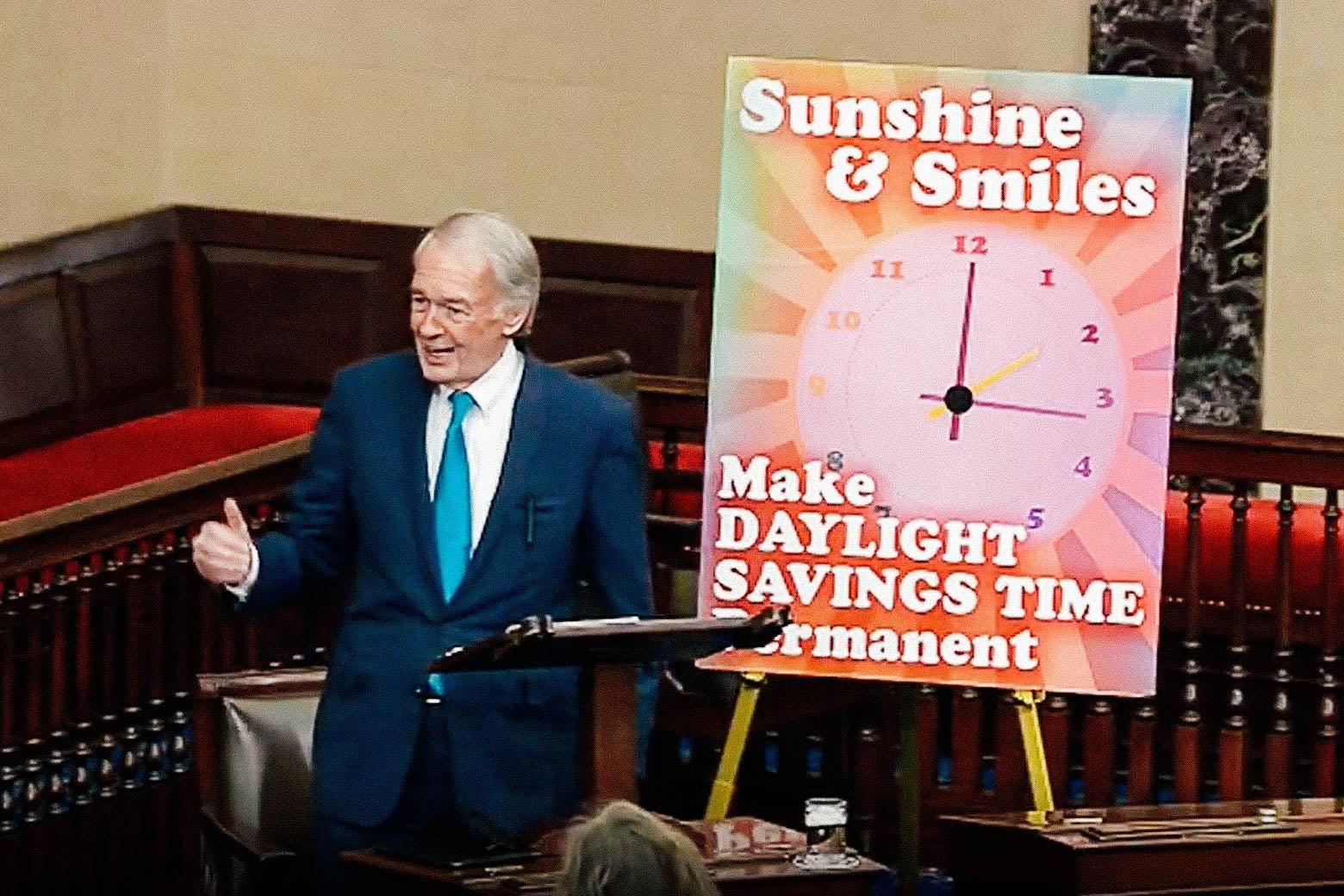A bill passed the Senate today to make Daylight Saving [not Savings] Time permanent. This, in effect, would redefine noon, in the US, to be the time of day indicated by 1pm on the clock.
This is, in effect, changing each state’s time zone to be the one next over to the east. So California will be in Mountain Time, Colorado will be in Central Time, Texas will be in the Eastern Time, and Georgia will be in Atlantic Time. (Some countries do this kind of thing.) Perhaps this is even more easily done than worrying about “daylight saving time.” Think how time zone maps of the world will look.

CNN, today: Senate passes bill that would make Daylight Saving Time permanent
The Hill, today: Senate unanimously approves making daylight saving time permanent
This is absurd. It’s to live in defiance of reality. It’s to pretend things that aren’t so. Ironically, the Senate bill is called the “Sunshine Protection Act” (but the names of congressional bills often say the opposite of what they mean). But the sunshine isn’t going anywhere. There won’t be more sunshine on any given day with or without Daylight Saving Time. I’m not sure everyone understands this.
This has been debated for years, of course.
NYT, 11 March 2022: Fall Back? Spring Ahead? How About Neither, Experts Say. Subtitled, “Here’s where the debate over changing the clocks stands, and what it could mean for you.”
This was published a few days ago, and has arguments for and against. They are all about the effects of sleep, of work and school schedules, and so on.
I get the impression that some DST advocates really think *more* sunshine is being created by passing such a law. Calling Phil Plait: what’s needed is a basic course in the planetary movements that explain the seasons. Also: there is far more variation among daylight hours in places north and south, e.g with less daylight in north during winter, than the effects caused by DST in any one location. If people in the north can live with tightening daylight hours in certain seasons, people in the south can too.
What I don’t see anywhere is this, a bigger perspective: Our work and school schedules have become established, over decades and centuries, for reasons, first and foremost circadian rhythms and the way people live their lives in accommodation to patterns of daylight and night. Prediction: if DST is set permanently, our work and school schedules will gradually slip back into the same patterns relative to sunrise and sunset as they were before. (It’s not as if some exterior power imposed those schedules on the population in defiance of practical wisdom.) And then we’ll have the same problems all over again.
As I said above: the advocates of permanent DST are seemingly unaware of how the things they are trying to solve are unsolvable problems to people hundreds and thousands of miles north of them. If you try to shift the clock to advantage people in one place — say, Florida, state of this bill’s sponsor, Marco Rubio — you will make things worse for people north of you.
The correct answer is: get rid of DST completely. Change personal schedules, even school or work schedules, as needed, locally — those that need to will be a smaller and smaller portion of the population (especially now that post-pandemic fewer people are traveling back and forth to work or school daily). Don’t redefine the clock, as if doing so changes the world.
\
Late this afternoon I saw the first opinion piece about the bill passed today.
Slate, Jim Newell, 15 March 2022 5:59pm (EDT): The Senate Unanimously Agreed to Make Daylight Saving Time Permanent. Huh?
The thing about moving to daylight saving time permanently, however, is that it does not actually create more sunlight. It would get dark an hour later in winter, sure. But it would also be very dark when people are waking up and going to work and school. In D.C., for example, sunrise under daylight saving time on Dec. 21 would be 8:23 a.m. It would be worse the farther west one is in a time zone. In Cleveland, the sunrise would be at 8:50 a.m. In Grand Rapids, Michigan, 9:11 a.m.
And there’s good evidence to believe that people might not like a change to permanent DST once it’s implemented. For example: the previous time the United States did this exact thing, and people hated it.
In 1973, President Richard Nixon, seeking to find a way to alleviate the pain of an energy crisis (and to do morning crimes in the darkness?), signed into law a year-round DST bill. This enjoyed wild polling support at the time. Shortly after it was implemented in 1974, though, people started going to work and school in the dark and polling support collapsed. It screwed up circadian rhythms! Everyone was losing it! It didn’t help with energy costs either. So the experiment wasn’t renewed.
\
Still, the House would have to pass this current bill too. And the president would have to sign it.
The White House didn’t immediately respond to a request for comment. But Joe Biden was in Congress when they tried this the first time, so possibly he remembers the backlash that ensued, and can recognize that sometimes the status quo is the status quo for a reason.






LQCs: Legislating Reality: Redefining “Noon”
A bill passed the Senate today to make Daylight Saving [not Savings] Time permanent. This, in effect, would redefine noon, in the US, to be the time of day indicated by 1pm on the clock.
This is, in effect, changing each state’s time zone to be the one next over to the east. So California will be in Mountain Time, Colorado will be in Central Time, Texas will be in the Eastern Time, and Georgia will be in Atlantic Time. (Some countries do this kind of thing.) Perhaps this is even more easily done than worrying about “daylight saving time.” Think how time zone maps of the world will look.
CNN, today: Senate passes bill that would make Daylight Saving Time permanent
The Hill, today: Senate unanimously approves making daylight saving time permanent
This is absurd. It’s to live in defiance of reality. It’s to pretend things that aren’t so. Ironically, the Senate bill is called the “Sunshine Protection Act” (but the names of congressional bills often say the opposite of what they mean). But the sunshine isn’t going anywhere. There won’t be more sunshine on any given day with or without Daylight Saving Time. I’m not sure everyone understands this.
This has been debated for years, of course.
NYT, 11 March 2022: Fall Back? Spring Ahead? How About Neither, Experts Say. Subtitled, “Here’s where the debate over changing the clocks stands, and what it could mean for you.”
This was published a few days ago, and has arguments for and against. They are all about the effects of sleep, of work and school schedules, and so on.
I get the impression that some DST advocates really think *more* sunshine is being created by passing such a law. Calling Phil Plait: what’s needed is a basic course in the planetary movements that explain the seasons. Also: there is far more variation among daylight hours in places north and south, e.g with less daylight in north during winter, than the effects caused by DST in any one location. If people in the north can live with tightening daylight hours in certain seasons, people in the south can too.
What I don’t see anywhere is this, a bigger perspective: Our work and school schedules have become established, over decades and centuries, for reasons, first and foremost circadian rhythms and the way people live their lives in accommodation to patterns of daylight and night. Prediction: if DST is set permanently, our work and school schedules will gradually slip back into the same patterns relative to sunrise and sunset as they were before. (It’s not as if some exterior power imposed those schedules on the population in defiance of practical wisdom.) And then we’ll have the same problems all over again.
As I said above: the advocates of permanent DST are seemingly unaware of how the things they are trying to solve are unsolvable problems to people hundreds and thousands of miles north of them. If you try to shift the clock to advantage people in one place — say, Florida, state of this bill’s sponsor, Marco Rubio — you will make things worse for people north of you.
The correct answer is: get rid of DST completely. Change personal schedules, even school or work schedules, as needed, locally — those that need to will be a smaller and smaller portion of the population (especially now that post-pandemic fewer people are traveling back and forth to work or school daily). Don’t redefine the clock, as if doing so changes the world.
\
Late this afternoon I saw the first opinion piece about the bill passed today.
Slate, Jim Newell, 15 March 2022 5:59pm (EDT): The Senate Unanimously Agreed to Make Daylight Saving Time Permanent. Huh?
\
Still, the House would have to pass this current bill too. And the president would have to sign it.